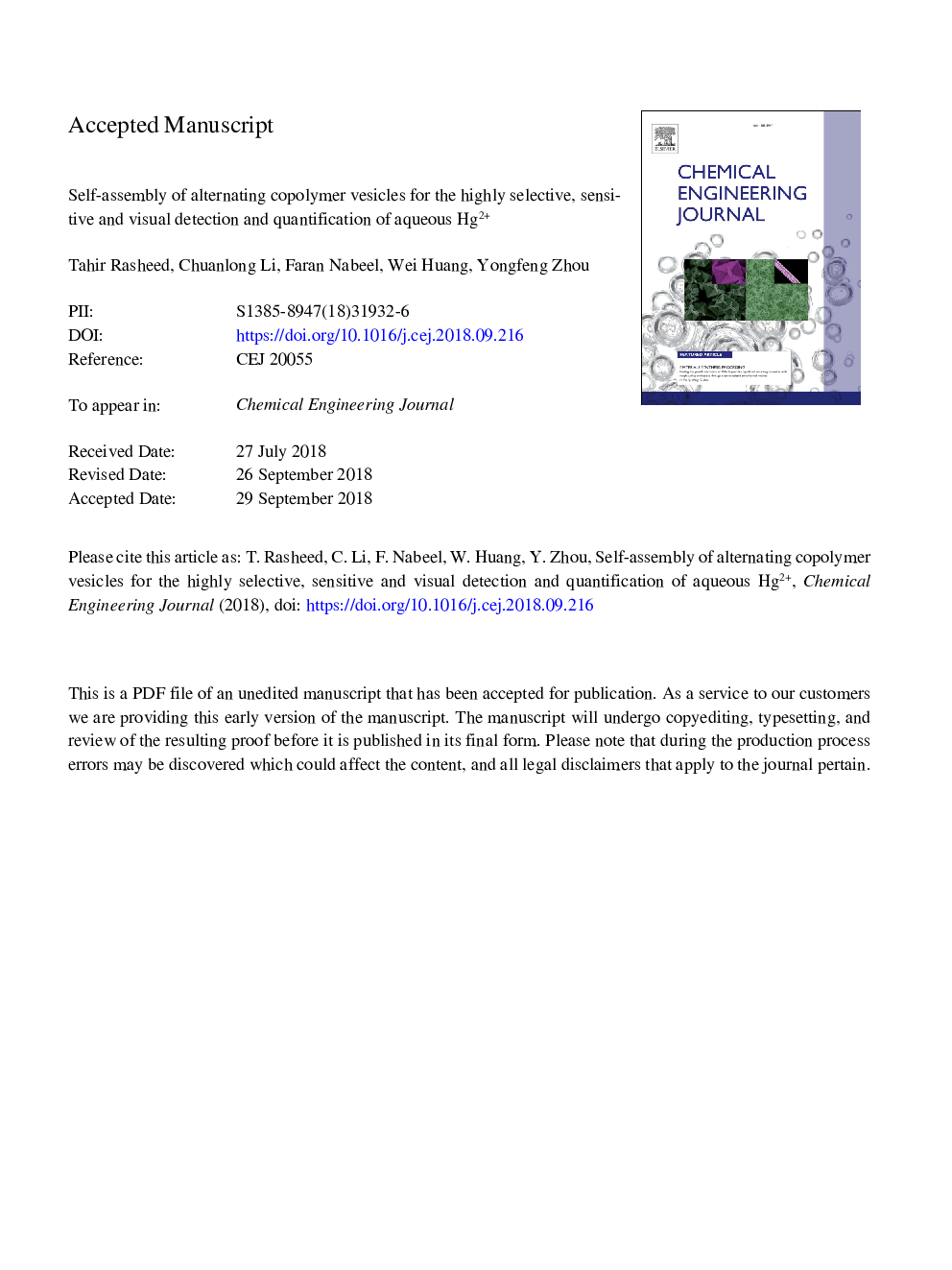| کد مقاله | کد نشریه | سال انتشار | مقاله انگلیسی | نسخه تمام متن |
|---|---|---|---|---|
| 11016642 | 1774266 | 2019 | 32 صفحه PDF | دانلود رایگان |
عنوان انگلیسی مقاله ISI
Self-assembly of alternating copolymer vesicles for the highly selective, sensitive and visual detection and quantification of aqueous Hg2+
دانلود مقاله + سفارش ترجمه
دانلود مقاله ISI انگلیسی
رایگان برای ایرانیان
کلمات کلیدی
موضوعات مرتبط
مهندسی و علوم پایه
مهندسی شیمی
مهندسی شیمی (عمومی)
پیش نمایش صفحه اول مقاله

چکیده انگلیسی
In recent years, there has been an ever-increasing demand to develop highly sensitive and selective colorimetric detection systems to tackle the growing threat of potentially toxic mercuric ions (Hg2+) exposure at the global level. However, most of the reported chemosensors for Hg2+ detection worked only in organic or in mixed solutions (organic/aqueous). The properties of the reported aqueous chemosensors for Hg2+ are not satisfactory. Herein, we take the advantage and present the first vesicular chemical sensor for the aqueous detection of Hg2+ with a high efficiency and selectivity. The vesicles were obtained through the aqueous self-assembly of the newly synthesized amphiphilic alternating copolymer poly(2, 3-dihydroxybutylene-alt-2,3-dihydroxybutylenedithioether) [P(DHB-a-DHBDT)] grafted with 2-(5-bromopyridine-2-yl)-3â²,6â²-bis(diethylamino)spiro[isoindoline-1,9â²-xanthene]-3-thione (PST) probes. After the addition of Hg2+, the colorless aqueous solution of the vesicles changed into pink color accompanied by the significant enhancement of photophysical (emission and absorption) intensities at 580â¯nm and 559â¯nm, respectively. This color transition from colorless to pink allows the “bare-eye” detection of Hg2+ ions in the aqueous medium. The vesicular sensor also shows high selectivity for Hg2+ detection among miscellaneous metal cations. The detection limit (LOD) is about 53.0â¯nM, which is approximately one or two order of magnitude higher than those of the reported aqueous Hg2+ chemosensors. The mechanism study indicates the significant enhancement of emission and absorption intensities in response to Hg2+ should be attributed to the spirolactam ring opening via photoinduced electron transfer (PET) of xanthene moiety in the PST probes. Most importantly, the newly developed polymeric vesicle sensors shows great potential for the detection and quantification of Hg2+ with excellent selectivity in real water samples with the percentage recovery of 102-98%.
ناشر
Database: Elsevier - ScienceDirect (ساینس دایرکت)
Journal: Chemical Engineering Journal - Volume 358, 15 February 2019, Pages 101-109
Journal: Chemical Engineering Journal - Volume 358, 15 February 2019, Pages 101-109
نویسندگان
Tahir Rasheed, Chuanlong Li, Faran Nabeel, Wei Huang, Yongfeng Zhou,